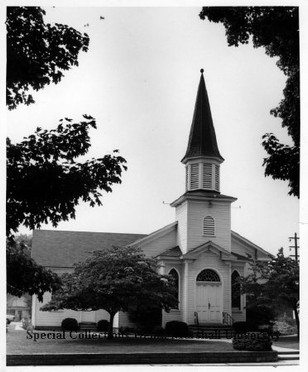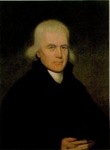Guyandotte United Methodist Church
Introduction
Text-to-speech Audio
Images
1869 United Methodist Church as of 2010. Photo courtesy of the Herald-Dispatch of Huntington WV (5/12/2015)

Church as seen in 1964. Photo courtesy of Marshall University Special Collections.

Francis Asbury "Father of American Methodism". Photo courtesy of Asbury University, Wilmore, KY.

Backstory and Context
Text-to-speech Audio
The Methodists were one of the earliest and largest religious groups to establish a presence in present-day West Virginia. The first Methodist churches were organized by the late 1700s. The success of the Methodist derived in large part from their use of the circuit rider system, in which a minister would travel through different communities and perform religious services at multiple locations. In this way, the church was able to maintain congregations across large and sparsely populated areas with relatively little manpower. In 1804 the Guyandotte Methodist Church was organized in the new growing community. Some say that it was founded directly by Francis Asbury, one of the leading Methodist bishops in the United States; he visited what is now West Virginia around 30 times. A church building was constructed at what is now the corner of 5th Avenue and Guyan Street. A graveyard was established behind the building; today it is one of the oldest cemeteries in Cabell County.
The Methodist Church was instrumental in promoting growth in the region. The county’s first grammar school was created and operated in the sanctuary for a number of years. In 1837 members of the Methodist church came together and organized the creation of a subscription school named Marshall Academy, which later evolved into Marshall University. Trustees for the school were church members, and at one point the church even controlled Marshall’s finances. The Methodist Church also led efforts to establish several other churches in the surrounding area. In 1844 the Guyandotte church, following the national Methodist church, split in two over the issue of slavery; the original church became the pro-slavery Guyandotte Episcopal Church South, while an anti-slavery congregation, Guyandotte Episcopal Church North, was organized elsewhere.
During the early months of the Civil War Union forces briefly occupied the church and used it to store supplies. In the aftermath of the Battle of Guyandotte on November 10, 1861, the church was allegedly set on fire and destroyed by vengeful Union soldiers. A new church building was not erected until 1869. The new structure, located on Main Street, was modeled off the New England Colonial style of church architecture. It was enlarged in 1905 and remains in use to this day. The bell in the steeple came from the river steamboat Henry M. Stanley, which sank in the Ohio River near Gallipolis, Ohio in 1907. Around 1939 the church was renamed the Guyandotte Methodist Church after the national North and South factions reunited; in 1968 the name changed again to the Guyandotte United Methodist Church after the national church merged with the Evangelical United Brethren Church.
Over the years many notable figures served as pastors at the Guyandotte church. These include Henry Bidleman Bascom, president of Transylvania University and a chaplain for the U.S. House of Representatives; W. R. Davis, a co-founder of Basker University; William McComas, who represented Virginia in the U.S. House of Representatives; and Harry C. Howard, who gave the first Mother’s Day sermon in Grafton, West Virginia on May 10, 1908.
Sources
“Community of Guyandotte full of rich history.” Herald-Dispatch. June 28, 2010. Accessed July 26, 2019. https://www.herald-dispatch.com/news/recent_news/community-of-guyandotte-full-of-rich-history/article_c35a9162-fb84-5cbf-a13b-d2f3c48ccfa1.html.
Lavender, Dave. “Guyandotte homes full of rich history.” Herald-Dispatch. November 5, 2011. Accessed July 26, 2019. https://www.herald-dispatch.com/features_entertainment/guyandotte-homes-full-of-rich-history/article_fcb3dd4b-8aab-54f1-ab37-7ed1f909aa4e.html.
Frey, Robert L. “Methodists.” e-WV: The West Virginia Encyclopedia. October 20, 2010. Accessed July 26, 2019. https://www.wvencyclopedia.org/articles/1768.
Geiger, Joe Jr. “The Tragic Fate of Guyandotte.” West Virginia History 54 (1995): 28-41.
Tabler, Dave. “Book Excerpt: ‘Images of America: Guyandotte.’” Appalachian History. March 27, 2014. Accessed July 26, 2019. http://www.appalachianhistory.net/2014/03/book-excerpt-images-america-guyandotte.html.
Withers, Bob. “Historic church in need.” Herald-Dispatch. October 5, 2010. Accessed July 26, 2019. https://www.herald-dispatch.com/news/historic-church-in-need/article_86fae861-91b1-5b92-bb39-7d057e642959.html.
